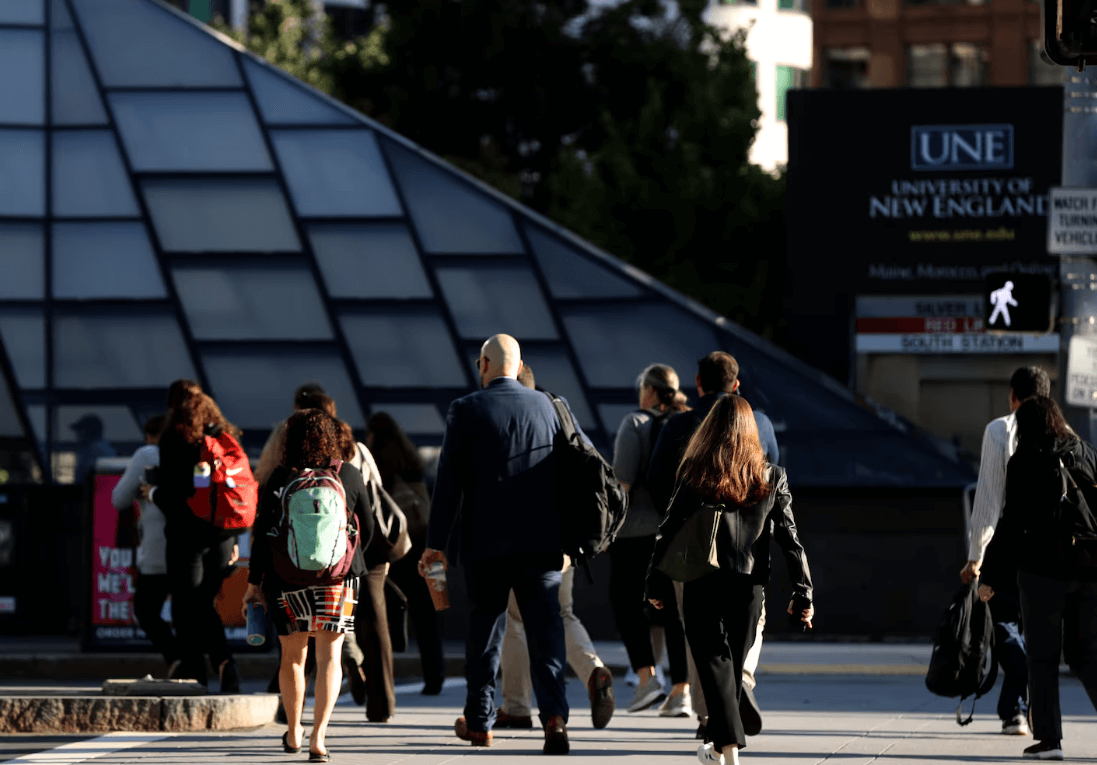最新人口普查数据显示,马萨诸塞州是美国收入最高的州

【中美创新时报2024 年 9 月 13 日编译讯】(记者温友平编译)去年,马萨诸塞州的中位家庭收入接近 10 万美元,是全美各州中最高的州。但该州最富和最穷的人之间的差距仍然很大。《波士顿环球报》记者Dana Gerber 和 Daigo Fujiwara-Smith对此作了下述报道。
2023 年,马萨诸塞州的家庭收入中位数接近 10 万美元,经通胀调整后比上一年增长了 1.5%,这表明居民的购买力正在逐渐接近疫情前的水平,尽管该州的穷人和富人之间的差距仍然很大。
根据美国人口普查局周四公布的估计,马萨诸塞州的中位收入为 99,858 美元,是全美各州中最高的,仅次于华盛顿特区。经通胀调整后,这比上一年增加了约 1,500 美元,这是自疫情爆发以来该数字首次增长。即便如此,这仍低于 2019 年的最高水平 102,632 美元(以今天的美元计算)。
但这个数字掩盖了马萨诸塞州更令人担忧的趋势——其中最重要的是最低收入者和最高收入者之间的巨大差距。
去年,最低收入家庭的比例有所下降——2023 年 26.6% 的家庭收入低于 50,000 美元,而 2022 年这一比例为 28.3%——而最富裕家庭的队伍却在扩大,2023 年超过五分之一的家庭收入达到或超过 200,000 美元。

“不幸的是,我们的联邦正在变成一个要么非常富有、过得还不错,要么真的入不敷出的地方,”波士顿前代理市长、现任非营利性经济流动途径总裁兼首席执行官金·珍妮 (Kim Janey) 说。她指出,根据人口普查数据,儿童贫困率有所上升,从 2022 年的 11.5% 上升到 2023 年的 12.6%。
即使对于那些收入较高的人而言,由于马萨诸塞州的生活成本高昂,从儿童保育到能源,尤其是住房等各方面成本都高得离谱,现金的威力仍然不如美国其他地方。
“中等收入家庭或中低收入家庭的经历与美国其他地区不同,”马萨诸塞大学多纳休研究所经济与公共政策研究主任马克·梅尔尼克 (Mark Melnik) 表示。
梅尔尼克表示,这种“中产阶级空心化”是全国性的趋势,但他认为,由于马萨诸塞州拥有大量高薪行业(如生物技术和专业咨询),导致整体中位数工资上涨,因此这一趋势在马萨诸塞州尤为突出。
“由于我们在某些行业集中度很高,因此在高端和低端之间的差距方面,我们最终会看到更深层次的分化,”梅尔尼克表示。
那么,马萨诸塞州去年领先意味着什么呢?
梅尔尼克说,在某种程度上,这可能有点侥幸,因为排名靠前的州——还包括新泽西州和马里兰州,这两个州在 2022 年都超过了马萨诸塞州——彼此之间的收入差距都在 1,000 美元左右。经济学杂志《MassBenchmarks》的高级特约编辑艾伦·克莱顿-马修斯 (Alan Clayton-Matthews) 表示,这种上涨可能是由疫情推动的高薪行业推动的。
“我想知道这是否部分是由于这里的医学科学和制药业与新冠疫情相关的大幅增长,”他说。“现在这种情况正在减弱,但该行业的收入,可能很多都是在 2023 年获得的。”
整个新英格兰地区的收入普遍较高。除华盛顿特区外,新罕布什尔州在最富裕州榜单上排名第四,家庭收入中位数为 96,838 美元,而康涅狄格州的家庭收入中位数排名第十,为 91,665 美元。罗德岛州排名第 14,家庭收入中位数为 84,972 美元,佛蒙特州排名第 17,家庭收入中位数为 81,211 美元。在新英格兰的六个州中,只有缅因州的家庭收入低于全国平均水平,平均家庭收入为 73,733 美元。
但可以肯定的是,没有哪个州是经济的巨无霸。波士顿大都会地区的牛顿、剑桥、萨默维尔等地区的平均收入都达到了六位数,而远离大波士顿的城市的收入远低于全州平均水平。
该州最贫穷的大城市斯普林菲尔德的家庭收入中位数略高于 47,000 美元,不到波士顿的一半。与此同时,最富裕的大城市牛顿的家庭收入中位数超过 185,000 美元,是福尔里弗的三倍多,福尔里弗的收入略低于 53,000 美元。
“整个州的中位数并不一定能说明不同地方可能出现哪些困难,”梅尔尼克说。
为了缩小这些差距,克莱顿-马修斯和珍妮都指出,应恢复疫情期间对低收入家庭的支持,例如扩大儿童税收抵免。为了壮大中产阶级,梅尔尼克表示,该州应该继续投资于清洁技术和人工智能等新兴行业。
“无论我们能不能站在这些新兴事物的前沿,我认为这都有助于我们为各个收入阶层创造就业机会,”他说。
珍妮在 2021 年 COVID 疫情高峰和金融余波期间担任代理市长,她警告说,即使经济指标令人鼓舞,该州也不应该自满。
“我认为我们可以很容易地说服自己,在马萨诸塞州,由于收入增加,我们的生活很好,但我们知道事实并非如此——尤其是当我们谈论那些正在经历贫困和面临其他多重挑战的家庭时,”她说。“我们不能被愚弄或哄骗,以为我们在这里取得了一些成就。”
题图:即使对于收入较高的人来说,由于马萨诸塞州的生活成本高昂,现金仍然没有其他地方那么强大。Jonathan Wiggs/Globe Staff
附原英文报道:
Mass. has the highest incomes of any state in the US, new Census data show
The median household here took home nearly $100,000 last year, yet the gap between the state’s richest and poorest remained pronounced
By Dana Gerber and Daigo Fujiwara-Smith Globe Staff,Updated September 12, 2024
The median household income in Massachusetts neared $100,000 in 2023, a 1.5 percent increase over the year prior when adjusted for inflation, a sign that residents are inching closer to pre-pandemic buying power, although the gap between the poor and the wealthy in the state remains pronounced.
At $99,858, the median income was the highest of any state in the country, lagging only Washington, D.C., according to estimates out Thursday from the US Census Bureau. That’s about a $1,500 hike from the previous year, when adjusted for inflation, the first time that figure has grown since the onset of the pandemic. Even so, that remains short of the 2019 high of $102,632 (in today’s dollars).
But that number belies more concerning trends taking place in Massachusetts — not least of which is the substantial chasm between the lowest and highest earners.
The share of the lowest-income households shrank last year — 26.6 percent of households earned less than $50,000 in 2023, compared to 28.3 percent in 2022 — while the ranks of the most affluent grew, with more than a fifth of households earning $200,000 or more in 2023.
″Our Commonwealth, sadly, is becoming a place where you are either very wealthy and are doing OK, or you are really struggling to make ends meet,” said Kim Janey, former acting mayor of Boston and now president and CEO of the nonprofit Economic Mobility Pathways. She pointed to an uptick in child poverty levels, which rose from 11.5 percent in 2022 to 12.6 percent in 2023, per census data.
And even for those on the higher end of the income spectrum, cash still doesn’t pack the punch it would elsewhere in the country due to the high cost-of-living in Massachusetts, with its outsized costs for everything from child care to energy and especially housing.
“The experiences of a middle-income family or lower-middle-income family, they’re going to look different than what they might be in other parts of the US,” said Mark Melnik, the director of economic and public policy research at the UMass Donahue Institute.
This “hollowing out of the middle” is a nationwide trend, Melnik said, but he believes it’s thrown into particularly sharp focus in Massachusetts due to the state’s preponderance of higher-paying industries — such as biotech and professional consulting — that drive up overall median wages.
“Because we have such a concentration in some of those industries, we end up seeing this deeper bifurcation when it comes to that spread between the high and the low end,” said Melnik.
So, what does it mean that Massachusetts led the pack last year?
To some extent, it was likely a bit of a fluke, said Melnik, since the top states — which also include New Jersey and Maryland, both of which had edged out Massachusetts in 2022 — are all within about $1,000 of one another. Alan Clayton-Matthews, senior contributing editor of the economics journal MassBenchmarks, said the uptick may have been fueled by the pandemic-driven boost to high-paying industries.
“I wonder if some of it was the big COVID-related surge in medical science here, and pharmaceuticals,” he said. “That’s waning now, but the incomes in that sector, probably a lot of those were received in 2023.″
Incomes were generally high across New England. Excluding D.C., New Hampshire ranked fourth on the list of most-affluent states, at $96,838, while Connecticut had the 10th-highest median household income, at $91,665. Rhode Island was 14th, at $84,972, and Vermont 17th at $81,211. Of the six New England states, only Maine lagged the national median, with a typical household income of $73,733.
But to be sure, no state is an economic monolith. While areas in the Boston metropolitan region — Newton, Cambridge, Somerville — all saw median incomes into the six figures, cities farther from Greater Boston saw earnings well below the statewide average.
Households in Springfield, the poorest large municipality in the state, had a median income of just over $47,000 — less than half of that in Boston. Meanwhile, Newton, the most affluent large municipality, clocked in a median household income of over $185,000, more than three times that of Fall River, at just under $53,000.
“The median for the entire state doesn’t necessarily tell the story about where some of the struggles may occur in different places,” said Melnik.
To close these gaps, both Clayton-Matthews and Janey pointed to reviving pandemic-era supports for lower-income families, such as the expanded child tax credit. To bolster the middle class, Melnik said the state should continue investments in growing industries, like clean tech and artificial intelligence.
“To whatever extent we can be at the front lines of some of these emergent things, I think it helps us be positioned to create jobs across the income spectrum,” he said.
Janey, who served as acting mayor in 2021 amid the height of COVID and its financial aftershocks, warned that even with encouraging economic indicators, the state should not fall into complacency.
“I think we could easily convince ourselves that in Massachusetts, because incomes have gotten higher, that we’re OK, but we know that is just not the case — particularly when we are talking about families who are experiencing poverty and who have other multiple challenges,” she said. “We cannot be fooled or lulled into thinking we’ve accomplished something here.”

